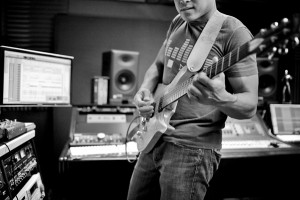 Quick Recap
Quick Recap
Reverb isn’t echo exactly and it’s not delay, even though it’s in the same family of effects. Reverb is a psycho-acoustic phenomenon. Turns out that just like our ability to tell one human face from another, our brains are really good at distinguishing the space in which sound is made. And because you have two ears, your brain can calculate not only the distance and type of space the sound is in, but also its location and movement. [editor’s note – read the December 2012 issue to catch up on everything you missed in Part 1.]
Saving “Space” on the BUS
Now that we understand the basics of what reverb is and how we can use it, it can be really easy to go overboard and start throwing reverb plug-ins on every channel. Let’s pump the breaks just a second before we end up drowning the mix in a sea of endless reverberation! First thing that you need to keep in mind when you are adding reverb to your tracks is that plug-ins need a ton of CPU power to run, and the more you add, the slower your computer will run. And there is nothing worse than a slow computer when you are trying to get the “platinum record” mix. We’ve found that rather than slapping a new reverb plug-in onto every channel you want to add a little more room to, simply place your reverb plug-in on a BUS (title it “Reverb” and have it return to the Master Bus). Then SEND every track you want reverb on to that BUS. This way you save your CPU usage, and all the instruments sent to this reverb will sound like they are in the same space, creating a superior mix (you can also set up more than one bus if you wish to have certain instruments sound like they are in their own unique space).
Timing Reverb to Your Track’s BPM
Using this little formula (60,000 / Tempo in BPM = 1 quarter note in milliseconds), you can “time” your reverb’s pre-delay to fit the musical tempo of the song you are mixing. So for example, if the song has a tempo of 120 BPM then 1 quarter note lasts for 500ms (an eighth note 250ms, sixteenth note 125ms, etc). Start by plugging in the BPM for your song into the formula and jotting down the values for the 1/4, 1/8, 1/16 and 32nd notes. Then crank up the reverb send on a track until it is way too wet and then dial in a quarter note pre-delay and see if it “feels right.” No? Then try the eighth note amount and listen again. Once you’ve got the right value for the pre-delay, lower the reverb send, forget about reverb for a while and come back to the mix later and see how ALL the tracks being sent to that reverb sound in the mix.
Practical Applications
It’s important to not get carried away using too much reverb on too many tracks. Remember, the main idea behind using reverb is that it creates the feeling of space in your mix, so if you end up throwing reverb on every track in your song, chances are you are going to have a mix that sounds like it’s being played across the street at your neighbor’s house party. So discretion is the key here! When adding reverb to a track, as a general rule, busy songs need less reverb and slower ballads with lots of space in the arrangement can afford to use more. If you are adding reverb to your instrument tracks, it’s usually a good idea to use the same one for all your instruments, then all reverberations of the instruments will sound as if they were recorded in the same environment (this works especially well for rock bands and creating that oh-so-magically “live” sound). Different types of reverb work well with different instruments. We find that room reverbs work well with drums and guitars, and sometimes a guitar can benefit nicely from a good spring reverb (especially for that psychedelic surf sound). Vocals, on the other hand, can be much more open to different types of reverb, depending on the style of music and the overall feeling of the song itself. It should also be noted that in general, we try not to add reverb to our bass instruments (bass guitar, kick drum, etc), as it tends to muddy up the mix. Now that you know some of the basics for using reverb, you can go crazy and experiment! You never know when you will find a sound that works just right for your mix, and if you have read any of our previous articles, then you know our golden rule: If it sounds good, do it!
Zac Cataldo is a musician and owner/producer at Night Train Studios, a recording studio in Westford, MA. He is also co-owner of Black Cloud Productions, a music publishing company. Reach him at [email protected].
Brent Godin is a bassist/guitarist and engineer/producer at Night Train Studios. He is also a talent scout at Black Cloud Productions. Reach him at [email protected].
